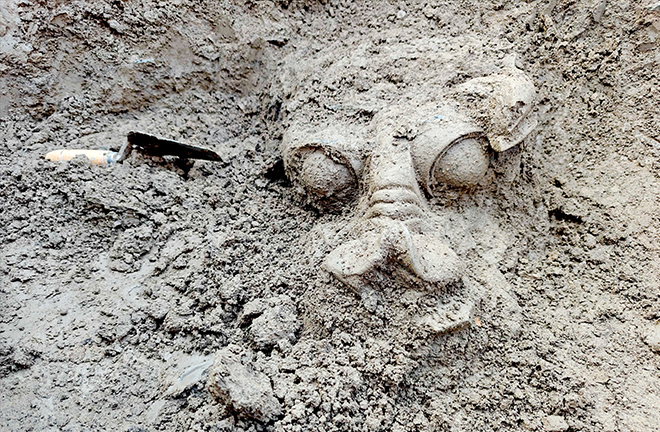Ceramic dragon head from Tang Dynasty unearthed in Xiong’an

The ceramic dragon head from the Tang Dynasty, unearthed at the Guzhou City ruins at Xiong’an New Area, Hebei Province Photo: PROVIDED TO CSST
On October 28, 2024, a joint archaeological team from the Institute of Archaeology at the Chinese Academy of Social Sciences and the Hebei Provincial Institute of Cultural Relics and Archaeology unearthed a rare Tang Dynasty (618–907) ceramic dragon head at the Guzhou City ruins in Xiong County, Xiong’an New Area, Hebei. The artifact was discovered in a brick and tile pit near a high-ranking Tang Dynasty temple. Alongside the dragon head, archaeologists found numerous Tang bricks and tiles, roof tiles adorned with lotus motifs, and Kaiyuan Tongbao coins. The dragon head, believed to have been a “ridge beast”—a decorative figurine placed at the end of a roof ridge in traditional Chinese architecture—was likely positioned on the temple’s roof ridge. The dating of the artifact is based on preliminary archaeological stratigraphy and accompanying relics, with further scientific analysis required for confirmation.
Rare discovery of dragon head
In Tang Dynasty architecture, dragons served as decorative symbols of auspiciousness, believed to protect buildings from natural disasters. Unlike the yellow-glazed dragon heads on Ming (1368–1644) and Qing (1644–1911) imperial palace roofs, which signified imperial status, this Tang-era dragon head is made of gray ceramic, with a rounded and robust form that reflects the inclusive spirit of Tang culture.
The discovery of this relatively well-preserved ceramic dragon head is rare for two main reasons. First, surviving Tang Dynasty buildings in China are very scarce, and the few remaining decorations have often been repaired or replaced during renovations by subsequent generations, making intact Tang architectural elements nearly impossible to see. Second, it is unlikely that many Tang ceramic ridge beasts remain buried, as more than a thousand years have passed since the Tang Dynasty. Given the fragility of ceramic materials, their survival over such a long period makes finding a well-preserved piece exceptionally rare.
Research has revealed that since their appearance in history, dragon heads have been essential decorative elements on the roofs of royal palaces, noble residences, temples, and other religious structures. Although Tang dragon heads no longer denoted the status they once did, their use continued in the Ming and Qing eras, albeit with limited scope and function. Furthermore, each building typically featured only a few ridge beasts—making surviving specimens even rarer.
The Sixteen Prefectures of Yanyun
To the southwest of the Guzhou City ruins lie the Maozhou City ruins, located less than 800 meters away, with 5- to 8-meter-high earthen city walls still standing today. Before 2017, the academic community had limited knowledge of these two city sites. However, ongoing archaeological work in recent years has gradually clarified their nature and history.
Research indicates that the Guzhou and Maozhou city ruins represent different periods of the ancient Mao Prefecture. During the late Tang and Five Dynasties (907–960) period, Mao Prefecture was one of the Sixteen Prefectures of Yanyun [historically known as 16 strategic administrative regions in northern China that were originally part of the Tang Dynasty’s territory] and remained under Khitan control for over twenty years. From the Five Dynasties to the early Northern Song Dynasty (960–1127), Mao City (the site of the prefectural administration during the Tang era, situated at today’s Guzhou City ruins) was abandoned, and a new Mao City (at today’s Maozhou City ruins) was built and put into use. At this point, the location of Mao City shifted from the present-day Guzhou City ruins to the present-day Maozhou City ruins, where it continued to develop through the Song, Jin, Yuan, Ming, and Qing dynasties up to the present day.
The relocation of Mao City has been tentatively explained through years of archaeological research. Along with the political fragmentation and warfare that marked the end of the Tang Dynasty, a catastrophic flood during the late Five Dynasties period is believed to have destroyed the Mao City at what is now the Guzhou City ruins. In the aftermath, the new Mao City (today’s Maozhou City ruins) was constructed on higher ground of a floodplain southwest of the old site, chosen for its strategic advantages in politics, society, and border defense.
The Guzhou and Maozhou city ruins reflect over 2,000 years of historical evolution. Today, the 5- to 8-meter-high earthen city walls remain standing, making them the best-preserved and most robust example of an ancient city site in Xiong’an New Area.
The earliest known “physical dragon” is an animal figure made from stacked stones, widely believed to represent a dragon totem. This figure was found at the Chahai Neolithic site in Fuxin, Liaoning Province, in 1994, and dates back over 8,000 years. The Tang Dynasty ceramic dragon head discovered at the Guzhou City site in Xiong’an, dated to around 1,400 years ago, provides new archaeological evidence for the evolution of dragon culture in China.
He Suili is an associate research fellow from the Institute of Archaeology at Chinese Academy of Social Sciences.
Edited by REN GUANHONG
